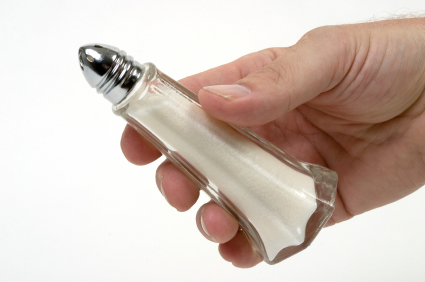 Piled on my desk on either side of my computer are several packages of convenience foods and one chocolate bar. The foods range from instant macaroni and cheese and cornbread mixes to canned soup, canned tuna, canned beans, and a Styrofoam container of instant, microwaveable macaroni and cheese. Of the eight items, only two – the tuna and the chocolate bar–have sodium levels in the single digits. Of the double-digiters, only two have sodium levels less than 20 percent.
Piled on my desk on either side of my computer are several packages of convenience foods and one chocolate bar. The foods range from instant macaroni and cheese and cornbread mixes to canned soup, canned tuna, canned beans, and a Styrofoam container of instant, microwaveable macaroni and cheese. Of the eight items, only two – the tuna and the chocolate bar–have sodium levels in the single digits. Of the double-digiters, only two have sodium levels less than 20 percent.
I’m looking at sodium content not because I’m watching my salt intake–although that’s hardly a bad idea–but because I wanted to see exactly what the New York City Department of Health and Mental Hygiene (the name brings a smile to my face every time I read it) is up to. In case you haven’t heard, the agency–along with more than 40 other government agencies and health organizations–issued a call Monday for the nation’s food producers to reduce sodium levels in their products by 25 percent by 2015. The 43 entities have joined together in an effort they’re calling the National Salt Reduction Initiative.
They have their work cut out for them.
Salt, of course, is everywhere. It’s a vital component of life; it’s a preservative for food. Most notably, it brings out the flavors of the food we eat. Given the ersatz nature of many of those products–I’m reluctant to call some of them “food”–salt plays an even bigger role, not just in enhancing flavor, but in providing it. Take the bright yellow container of Velveeta Shells & Cheese immediately to my left. It contains 640 milligrams of sodium; that’s 27 percent of the recommended daily allowance of salt based on a 2,000 calorie diet. The Centers for Disease Control and Prevention, however, suggest that 1,500 milligrams is probably the most reasonable amount for most adults. Americans consume almost twice that each day. We really only require about 500 milligrams, or roughly half a teaspoon.
Rich in such ingredients as glycerol monostearate, an emulsifier, acetylated monoglyceride, another emulsifier, and modified food starch, Kraft’s microwaveable cheese food product and pasta needs plenty of back up to boost what little real flavor it might actually have.
There is also a can of Cambell’s condensed chicken noodle soup, featuring 25 percent less sodium than their regular chicken soup. That’s good news until you read the label: it still contains 660 milligrams of sodium, or 28 percent of the RDA. Even more startling is that those are the levels per serving. The label says there are two-and-a-half servings per can. Eat the whole thing, as most folks will, and you’ve overshot the CDC’s recommendations by 150 milligrams and that’s assuming you’re not eating a sandwich or dressed salad along with it.
Sodium itself, of course, appears in probably thousands of guises. The salt we encounter most frequently is sodium chloride, or common table salt. Look at the label on that can of soup again. Salt appears in at least five different forms: lower sodium natural sea salt (“contains less sodium than regular salt”), salt, monosodium glutamate, yeast extract (another name for MSG), and sodium phosphate. That last ingredient isn’t there for flavor; it’s being used as an emulsifier (it also works as a leavening agent).
Is the New York health department being realistic? Corporate responses seem to be slow in coming, although both Cambell Soup Company and Con-Agra have responded by reiterating their own sodium reduction campaigns.
“Their [New York City’s] sodium reduction vision is laudable,” said Chor-San Khoo, vice president of Campbell’s Global Nutrition and Health, in a release.”However the targets proposed are quite aggressive and difficult to achieve, particularly in the recommended timeframes.”
And particularly when so much of today’s food depends upon salt, instead of wholesome ingredients, for flavor.



